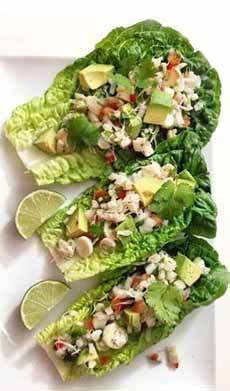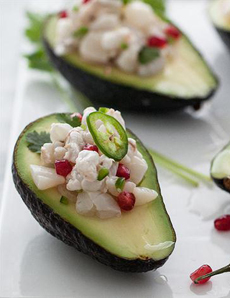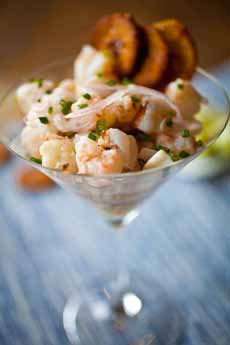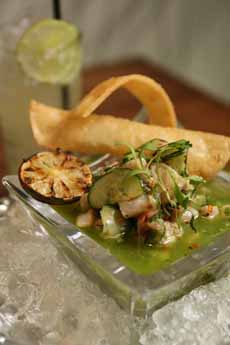RECIPE: Ceviche & Ceviche Lettuce Cups
 [1] Ceviche in lettuce cups (photo © The Chalk Board Magazine).
|
A light lunch or first course on a hot summer day…high in protein, low in calories and carbs…a fusion of a popular seafood dish and lettuce “cups…” It’s ceviche lettuce cups (photo #1).
Originally made as a “vegan ceviche” recipe from The Chalkboard Magazine, we adapted the concept to a mix of fresh fish and shellfish (the mix is up to you). > Why ceviche is good for you. > More ceviche recipes. Ceviche (pronounced say-VEE-chay, also spelled cebiche, seviche, and sebiche based on region—the Spanish pronounced a “v” as “b”) is a dish of fish and/or shellfish cured by acidic citrus juice—typically lime juice. It includes onions and other vegetables. It has been popular in Latin America for many centuries: It’s one of the national dishes of Peru, and its roots go back for millennia. In the early 1500s, the Spanish conquistadors wrote of an Inca dish of raw fish marinated in chicha, a fermented maize beer. That recipe dates back some 2,000 years. Other curing methods used tumbo (Passiflora tarminina, a relative of passionfruit), or salt and fermented corn. The concept evolved into ceviche: raw fish or shellfish cured with citrus juice. Over time, fruits were incorporated; most popularly, tomatoes (native to Peru) and mango. A chemical process occurs when the fish/shellfish is marinated in the highly acidic citrus juice, which denatures the protein. The result is similar to what happens when the fish is cooked with heat. Instead of “cooking,” however, the fish is cured in the marinade, which adds its own delicious flavors. Both Ecuador and Peru claim to have originated ceviche; both were part of the Incan Empire. But why quibble: Today, ceviche—or seviche or sebiche—is so popular that there are cevicherias, restaurants that specialize in ceviche. The Spanish brought to Peru the limes, onions, and bell peppers that are integral to modern ceviche. In fact, the term “ceviche” is thought to come from the Spanish escabeche, meaning marinade. Others argue that the word comes from the Quechua (Incan) word siwichi [source]. Ceviche is found in almost all restaurants on the coast of Peru, typically served with camote (sweet potato, which originated in Peru). It has been called “the flagship dish of coastal cuisine,” and is one of the most popular dishes in Peru [source]. June 28th is National Ceviche Day. Ceviche is part of a group of refreshing raw or cured fish dishes, including: As with the other dishes, ceviche welcomes almost every type of fish and shellfish. You can also vary the: |
|
|
RECIPE: CEVICHE LETTUCE CUPS Bibb and butter lettuces turn into natural “cups,” while baby romaine leaves are sturdy and can be picked up to eat by hand (the different types of lettuce). Ingredients Accompaniments You don’t need anything more with the ceviche, but popular accompaniments include: 1. PREPARE the ceviche and keep it in the fridge. You can do this a day in advance. When ready to serve… 2. PREPARE the lettuce leaves: wash and pat dry. Fill each leaf with a scoop of ceviche. 3. GARNISH as desired. CHECK OUT WHAT’S HAPPENING ON OUR HOME PAGE, THENIBBLE.COM.
|
||





